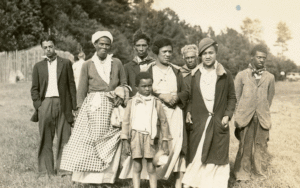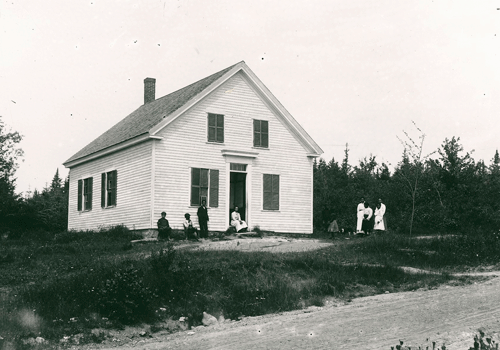About a mile off Route 1 in the woods of Warren is an off-the-beaten track cemetery. It is the only physical remnant accessible to the public of Peterborough, a once-thriving interracial community that had a major impact on building the economy of coastal Maine. The community was the subject of a webinar held in January as part of the Maine Conservation Voters’ (MCV) Lunch and Learn series.
Besides Portland and Bangor, Peterborough—sometimes spelled Peterboro—was at one time the largest African American community in Maine—even larger than the more well-known community of Malaga Island—said Kate McMahon, MCV’s guest speaker.

McMahon, a Shapleigh native whose master’s thesis at the University of Southern Maine was on the African American community of Peterborough, is a museum specialist at the Smithsonian Institution’s Center for the Study of Global Slavery that’s part of the National Museum of African American History and Culture.
Peterborough was founded by a Revolutionary War veteran named Amos Peters and his wife, Sarah, a former slave who was kidnapped from her native Guinea and sold by a ship captain from Damariscotta to a family in Warren.
Sarah Peters gained her freedom after hearing lawsuits in Massachusetts that led to the banning of slavery…
Sarah Peters gained her freedom in the mid-1780s after hearing through word of mouth of the successful lawsuits in Massachusetts that led to the banning of slavery in the state, including the District of Maine. She hired a lawyer who successfully argued for her freedom.
The founders of the community that would exist for about 150 years were “powerful figures” who were “revolutionary thinkers,” McMahon said in an interview with the The Working Waterfront for the newspaper’s bicentennial road trip series published last summer. “[Theirs is] a story of self-determination and community building,” she said.
Amos Peters, born around 1737 in Plymouth, Mass., of African and Wampanoag Indian ancestry, served two enlistments in the Revolutionary War. It was during that time that McMahon believes he encountered General Henry Knox, the chief artillery officer of the Continental Army and the first U.S. Secretary of War.
Knox’s wife’s family lay claim to more than 500,000 acres of land in the District of Maine. For reasons unknown, said McMahon, Knox gave Amos Peters, who moved to the Warren area in the 1780s, 150 acres of land.
The land Knox gave Peters, near South Pond, wasn’t of poor quality. It was good, farmable land and it became the engine that powered the Peters’ growing family and the community that grew up around that family generation after generation, she said.
By 1820, the year the District of Maine became a state, more than 50 members of the extended Peters family lived in Peterborough. By 1823, the town of Warren allowed Peterborough to have its own school district and by the 1840s, the community had more than 100 people and its own schoolhouse.
In this period before the Civil War, even though Maine did not allow slavery, racism and segregation existed in many communities, including Warren, she said.
“Having this separate community gave them a lot of power, a lot of agency, and the ability to resist some of these more overt structures [of racism and segregation],” she said in the bicentennial road trip interview.
“It’s a great story of how despite the fact that their community has essentially been erased from the environment—the only structure that still exists is the cemetery—they have really had a major impact on the shape of coastal Maine, especially,” she said.

The extended Peters family and members of the larger Peterborough community contributed to construction of buildings in the area—Amos Peters and his sons helped to build the Knox family mansion, Montpelier, in Thomaston—worked on road crews that built road networks allowing for more efficient movement of goods and people, and were a large part of the maritime economy, working as sailors and shipbuilders or in trades that supported the maritime trade.
After losing a significant number of young men during the Civil War and as members of the community began migrating to new places when the maritime trades began to wane and factory work gained ground (they were excluded from working in the local factory), Peterborough began declining. While there are many descendants still living in the area today, the last of Peterborough’s residents left in the 1950s.
Watch the video of the webinar here: https://www.maineconservation.org/lunchnlearn/land-and-liberty-the-historic-african-american-community-of-peterborough




